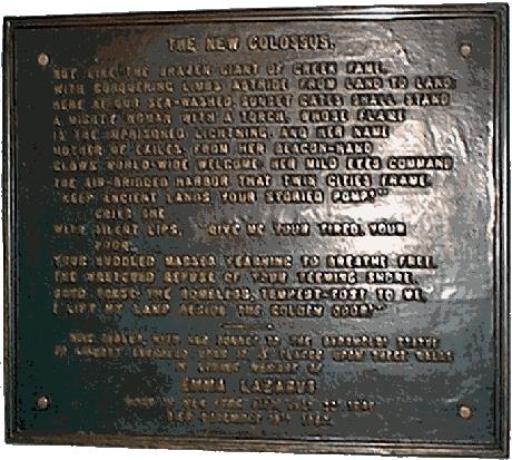The New Colossus |
|||||||
|---|---|---|---|---|---|---|---|
| Primary Creator |
|
||||||
| Contributor(s) |
|
||||||
| Properties |
|
||||||
| Name of Work | The New Colossus | ||||||
| Production Date | 1883 | ||||||
| Production Location |
|
||||||
| Current Location |
|
||||||
| Media Types | |||||||
| General Notes | The title and opening lines make reference to the ancient Colossus at Rhodes, a "conquering" figure rather than a welcoming one. The "twin cities" refer to New York and Brooklyn, which were note yet legally joined as one city. The "air-bridged harbor" refers to the Brooklyn Bridge, which was completed the same year as the poem. The "imprisoned lightning" refers to the electric light of the torch, a new technology at the time. The sonnet's rhyme scheme follows the "Petrarchan" pattern. | ||||||
Description
This sonnet, written about the Statue of Liberty, is engraved on a bronze plaque inside that statue. The poem celebrates America's welcoming promise to people who are oppressed in other lands.
Theme
A marvelous land of liberty offers welcome to the oppressed of the world.
Emotional Sum or Sense-of-life
Benevolent celebration of liberty as a beacon to a troubled world.
Context Information
Tags


Related Media
Text of poem
(32.89 KB)
Discussion
- Log in to post comments
commentaryOne of the things I like about this entry is that you describe the underlying meaning of certain phrases that otherwise might not be specifically understood. That adds to the esthetic value of the work, which is odd in a way, since I normally maintain that an artwork should be able to stand on its own without mediation by analysts, critics, commentators.
And actually that still holds here, since the work itself, even if one did not understand that a certain phrase referred to the Brooklyn Bridge, stands on its own as a lyrical poetical work. If it did not, we would be in the territory of "the Painted Word" which was well-attacked by Tom Wolfe many years ago. So, what I'm saying is that your simple additional info enhances the poem for me upon another reading -- which is a perfectly valid added value, as long as the work still can stand on its own as an emotional product.